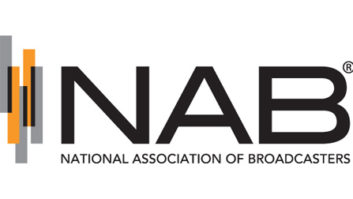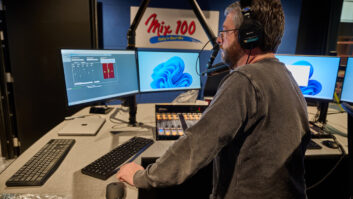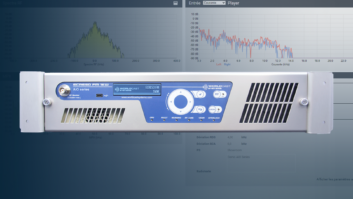(click thumbnail)Donn WerrbachIt has been said that audio processing is personal. You may not know the name of the person who designed your CD player or console, but you may well know who invented your on-air processor.
If you use a product from Aphex Systems, there’s a good chance it was designed by Donn Werrbach.
The company has been around since 1975 and grew from a single product: the Aural Exciter, invented by Curt Knoppel.
In the 1970s, an album credit from Linda Ronstadt and a Wings tour credit gave the company a higher profile, and it moved from Massachusetts to California. Now in Sun Valley, its product line has expanded to include processors used by recording studios, broadcasters and other professionals.
In 1984 the owner, Marvin Caesar, convinced Werrbach to move from Hawaii to California to take over the duties of chief engineer. Every Aphex product since 1985 has been designed by Werrbach, now the company’s vice president of engineering.
Werrbach spoke about his career and the line of Aphex products with Radio World Technical Consultant Tom McGinley.
RW: Aphex is well-known for audio processing products that are used both in the studio and in the air chain. Tell us a little about the design philosophy behind early products like the Compellor and Dominator.
Werrbach: The Compellor and Dominator have proven to be our most successful products. I think that’s because they address the two most critical and fundamental areas of dynamic range control: average level and peak level.
Traditional comp/limiters have been used to address these problems, but they are relatively primitive and impart an audible change.
But what if I don’t want that and just want the sound to be the same as before? It has always been my curse to have to keep reinventing the wheel. I can’t help myself and I just can’t stop experimenting. So that’s become my design philosophy. I want everything I create to add something to the art; to take it to a new level; to be innovative.
My approach to creating products is to imagine some kind of tool that is needed but not available or to make a process sound better through some kind of clever algorithm that I have to discover.
RW: The Compellor has become perhaps the world standard for a stand-alone smart AGC unit, found in almost every radio station and production studio. With 20/20 hindsight, why do you think it became so popular?
Werrbach: I did not expect or even dream that the Compellor would go so far. Naturally, I hoped it would be successful, but I didn’t really have an idea what that meant. I was totally flattered even to have a company like Aphex take an interest and then work with me to bring it to the market.
It was my first commercial product and to see it become so successful has been my greatest thrill. It sells basically on its reputation alone. We are shipping as many as ever, 18 years after its introduction. Other companies have tried to bring out a competing processor, but they have not succeeded in matching the sonic performance of a Compellor. One reason is that our patented processing techniques are very hard to duplicate.
RW: From the beginning, Aphex has favored analog audio processing designs over digital processing techniques. How has that philosophy evolved and influenced the new generation of Aphex products?
Werrbach: We still know that, at the purely sonic level, analog is better than digital. That is a God-given fact, and nothing will ever change it because digital is a quantized and sampled numeric approximation of reality.
However, digital audio is a growing and demanding market that is displacing, to some extent, the analog market. We still find a strong market for our analog equipment because of two things.
First, there is a demand for high-quality processing that is not being supplied by digital processors because of technical limitations. Second, there is always an analog front and back end. Digital is just an intermediate step where sound is stored, mixed and edited.
The field of digital audio production is a very important target for most audio equipment companies, and we do have our battle plans in the works. We have brought out our Aural Exciter and Big Bottom as plug-ins for a first entry.
However, we have learned that hardware-based digital audio products are much more important for the industry. We are expending a great deal of research expense to develop digital signal processors of that type.
Our biggest advantage in the industry is that we have so many advanced and patented audio processing techniques in analog that we can bring into digital. Our greatest problem is that digital signal processing hardware is still so primitive. Capturing the sonic quality of our analog products will require very high sampling rates and intense DSP algorithms that present hardware can’t really handle at a low cost.
Nevertheless, our philosophy is to maximize the digital audio performance over putting tons of so-so effects into a single unit. We expect to begin releasing high-quality, all-digital products within the next 14 months.
RW: Your most ambitious product is the 2020 Broadcast Audio processor.
Werrbach: The model 2020 took a long time to create and bring to fruition. It comprises more than 13 patented audio processing technologies, more than any other audio product I have ever heard of.
It was designed to go into FM radio stations and serve as the final audio processor before transmission. It combines circuits to level out the program, add multiband compression to improve program consistency, limit peaks for maximum total modulation, and deal with transmission problems caused by pre-emphasis.
It also contains a digital I/O interface and a stereo multiplex generator. Fortunately, I designed the 2020 to be modular so certain processing sections can be supplied as options. That means they can be omitted for non-FM broadcast applications like mastering studios and such. This opened up a number of possibilities to use it outside of FM stations, and we have sold many to non-FM customers.
It makes a fantastic mastering tool, and it is also useful for general recording and live sound. Because it is digitally controlled, it can be run from a PC and has preset storage for instant recall of designed settings.
The biggest thing about the 2020 is that all of the processing is in analog. There is no loss of quality due to aliasing and other typical DSP problems of other products. The sound produced is very clean and natural.
We feel our best bet is to model our patented, successful and unique analog processing algorithms. We are discovering that some of them are very hard to duplicate accurately in digital.
RW: The original 2020 has been replaced by the 2020 MkII. We understand this is a substantially improved design and not merely an updated version. Describe the differences.
Werrbach: The MkII is certainly an improvement, not that the original wasn’t great too.
What I did was to reinvent the “back end” of the processor and let certain improvements ripple backwards. In the summer of 2000, I was in Germany visiting the WDR federally run broadcasting company. I was impressed by the fact that German audio engineers have a certain kind of sound they like.
It is reflected in everything. They love big diaphragm condenser mics, and they love their Genelec speakers. Voices are surrealistic, and very close sounding like they are spoken next to your ear. The highs are sharp and strong while bass is somewhat restrained compared to American tastes.
I felt that I wanted to make the 2020 more capable of matching that sound for the German broadcast market. I also felt that if I could do that, I could make it sound a little sweeter for everyone else, too.
The result is probably the cleanest multiplex spectrum of any FM processor and no appreciable overshoot. I also took advantage of the opportunity to upgrade the stereo generator module with dual outputs and other added features.
We reconfigured the leveler module so it can be split into dual independent processing channels. That allows the MkII to now act as two independent mono processors for users who had asked for it, such as TV networks and Webcasters.
RW: Is there an upgrade path for current 2020 users?
Werrbach: Yes, we are providing an upgrade path for Model 2020 owners who want to turn them into MkII’s. All the information about that is on our Web site (www.aphex.com). For a very nominal cost, you get all the audio processing features of the MkII but you don’t get the updated stereo generator or the new front-panel aesthetics.
RW: Is there something unique about the 2020 Mk II pre-emphasis filter? Is this one of the keys to the performance the unit achieves?
Werrbach: Yes, of course. One of my patented inventions is the distributed pre-emphasis filter. This allows me to divide the pre-emphasis curve into two sequential stages where the pre-emphasis can be added more gradually.
In the 2020 it is divided among the multiband compressor and pre-emphasis limiter sections. This helps keep the sound well-balanced, even when we call for heavy processing.
RW: Who was involved in the development of the 2020 Mk II?Werrbach: There are three people I would like to thank: Gary Liden, Kim Steffensen and Richard Faith. These comprised Aphex’s entire engineering staff at that time, and I taxed them all. Without them I would still have proto boards wired together all over my workbench.
RW: What are the next important product introductions that we should expect to see from the company?
Werrbach: I have launched the Thermionics line, which I intend to keep driving. We released the Model 1100 Thermionic Mic Preamp more than a year ago and it is getting unbelievable raves for its sound.
There are a number of products in the works, one of which is a comprehensive voice processor/mic preamp. This will comprise numerous processing stages and some newly developed technology for de-essing and spatial enhancement. There will be multiband compression, and downward expansion, equalization, etc., and it will contain a super quality digital audio output. Of course, it will be based on my Reflected Plate Amplifier tube patent.
I also am pre-designing a very high-quality direct box, a studio quality power amplifier, and other things that I don’t want to jinx by talking more about just yet.
Outside of Thermionics, we are releasing our new Model 204 Aural Exciter with Optical Big Bottom. There will be more 200 series products to come after that. Besides all that, we are working intensely on a new line of digital audio products that we expect to begin releasing some time next year.
RW: Is there such a thing as a “Donn Sound” that sets Aphex products apart from those of other audio processing products?
Werrbach: I suppose I’d have to say the answer is yes, just out of practicality.
I always design while listening. As to what my “Donn Sound” comprises, it’s hard to verbalize. To try and describe what I listen for, I love deep unrestricted and easy flowing bass. I hate it when bass sounds like it is high-passed, boxy, or pinched back. I spend a great deal of time studying bass and learning ways to process it more musically.
I love present and forthright vocals. I hate it when a vocal sinks back into the mix when other instruments are layered on, unless it is an artistic effect. I love definition. I love to be able to distinguish all the various instruments in a mix.
I like to be involved in the listening experience. Anything that clouds or masks definition and devolves the imaging makes me unhappy.
I don’t like harsh digital distortion. It hugely aggravates me and I hear it all the time these days. Once you become sensitive to detecting digital grunge, you are cursed forever. I spend a lot of time looking for better compression and limiting algorithms, and of course that is purely judgmental but it lets me play god just a little.
RW: Some of your products like the Tubessence mic preamplifier use vacuum tubes. How do you describe the sonic differences and advantages of employing such vintage technology in an age dominated by digital techniques? Are the differences really significant or just nuance?
Werrbach: With digital audio recording and production, a whole new dimension of creative freedom is available.
However, with all the great utility of digital production, engineers and producers have accepted a profound amount of audio degradation. The total digital mix seems to somehow go bad. It gets flat, dry and edgy.
For some kinds of music this is good, and art tends to fit the tools and instruments used by the artist, so a lot of the modern music forms are coming out unintentionally featuring these digital artifacts.
However, this is seen as a problem by many artists and producers. They wish they could get the beautiful, layered and dimensional mixes that can be made with analog. By passing tracks or a whole mix through a piece of analog tube electronics, some of the fine detail can sometimes be recreated and the sound improved. The question is, “Why tube, and why analog?”
Tube circuits are inherently analog, and they are not numerically linear like digital. Tube circuits comprise numerous nonlinear properties following mathematical laws that are foreign even to solid-state circuitry. That’s another way of saying they generate unique distortion and compression effects that can’t be duplicated digitally. There is no true digital model of a tube circuit. To get the real tone and responsiveness, you still need the real tube amp.
We have been told by our customers, many of them the crem de la crem of professional recording, that our thermionic mic preamps just have a big, beautiful sound they have almost never been able to capture before.
I know that is a psycho-acoustic effect of the tube’s characteristics from the many hours of listening experiments in my lab. We can actually measure the specific distortion curve, but there are no methods yet devised to accurately measure any of the subtle temporal or dynamic effects. Some of the tube “magic” still remains empirical. That is one reason we can’t package this effect into a digital signal processor.
RW: What about “digital grunge”? You have built your products on the belief that the best analog audio processor can still be adjusted to sound “better” than any digital unit in terms of warmth and lack of unfriendly distortion by-products at the same loudness levels. Explain why this is.
Werrbach: Digital grunge is real enough. It can be reduced in digital signal processors by exhaustive algorithm development. However, that may heavily burden the DSP power that is economically available. Therefore, you find the grunge gets into everything eventually.
What constitutes digital grunge is the numerical rounding and truncation that is often re-entrant or recirculatory in the DSP code, and aliasing products generated by any nonlinear function like gating, clipping, compression or limiting.
Digital workstations are based upon DSP engines running DSP code that can have all these adversities in varying amounts depending upon the skills of the algorithm designer and codewriter and the extents of processing.
Just straight mixing on some workstations causes audible grunge. Grunge can creep in at CD mastering even off an analog master because of the A/D conversion and the DSP that is used for coding the CD format. This kind of distortion is distinctly unnatural. No object in nature creates anything like digital grunge. Analog distortion is comparatively benign because harmonic and intermodulation distortion can be found in nature.
That is one reason a good analog audio processor can sound better than a digital unit. Another reason is that advanced analog processing algorithms are far easier to develop through experimentation.
To develop digital processing algorithms, first you have to abstractly conceive of what you want to try. Then you have to write extensive code to implement it to whatever approximation you are allowed by available processing power. Then you have to compile the code, load it into a target processor and finally run some audio through it to listen to the result.
Many DSP algorithm designers just test their code on an offline simulator and never actually listen to it in real time. Those who do run real-time testing can never hope to test as many ideas as the analog designer within a reasonable time window. That is why, to this time, digital processors contain nothing but primitive algorithms approximately comparable to the analog art of 50 years ago.
It is fairly obvious that the most reasonable path to developing better digital processing is to model advanced analog processors. Until that happens, and the problems of digital grunge are truly eliminated, analog processors will always sound better.
RW: What is your opinion of the ongoing loudness wars being waged by stations on both the AM and FM bands? Will the evolution of digital broadcasting and the Internet change the general sensibilities of most programmers that being loud will always be important?
Werrbach: Digital broadcasting will not end the loudness wars.
Some of us thought, just for a fleeting delirious moment, that it would. However, the dynamics of commercial broadcasting are proving to be just the same as analog FM and AM. That goes for Webcasting as well. Programmers seek every tool at their disposal to beat their competition and loudness is one of the tools.
A possible exception could be direct satellite or cable radio where all the channels are exclusive and originated by the same company. Then there is no direct competition between channels. In that case, audio processing is usually omitted altogether and that causes problems. There needs to be at least moderate processing to hold up program consistency and peak control over the medium.
RW: What will the coming of Ibiquity Digital broadcasting mean for broadcast audio processing? What is Aphex doing to get ready for the implementation of this new medium?
Werrbach: As far as Aphex is concerned, we’re ready now. Our 2020 MkII is modular and can be configured without pre-emphasis or a stereo generator. We have high-resolution digital audio I/O already available.
The main difference for iDAB, or IBOC as it is also called, is that it is not pre-emphasized or limited to 15 kHz bandwidth. That is going to improve the sound of the medium immensely if the technology for iDAB can ever reach all the milestones and become practical enough to actually be implemented widely.
RW: On-air processing is a subjective arena, and it’s a business that seems to be more and more defined by the marketing of high-profile personalities like Bob Orban and Frank Foti. Where do see yourself and Aphex fitting into this competitive landscape?
Werrbach: Well, I don’t see myself getting into a hissing war with either gentleman, although the competition is warming up.
As most can remember, Foti came out, some would say recklessly, with a negative campaign against Orban’s 8200 processor. He ran some ads about the 8200’s digital grunge.
Naturally, Orban’s company struck back, and that is when we saw Bob himself being put out on display in their ads. They merely downplayed the grunge issue and pitted Bob Orban’s professional credibility against that of Frank Foti as they cast Frank Foti as a junk scientist and Bob Orban as the master of audio design.
It has been a sad battle ever since. It appears that Frank may have felt the sting because he has turned away from the direct credibility confrontation as far as I can see and concentrated on proving himself and his products.
I think we will see the high-profile personalities drop more into the background and the product marketing become more hardware oriented.
I believe that both Orban and Foti view Aphex as insignificant competition. They are keenly focused on each other. Meanwhile, we have made deep inroads and have taken some hallowed ground away from both.
We continue harping on our better sound quality and let everybody compare boxes to make up their own minds. Our analog sweetness and clarity, as well as the more advanced analog processing algorithms, wins a lot of races, especially with the new MkII release. We are certainly in it for the long run and intend to continue pressing into that market.
RW: Assess the quality of audio compression or bit-rate reduction algorithms used in digital audio today, and how much improvement we should expect in the future?
Werrbach: I always recommend using uncompressed digital media whenever possible to anyone that will listen. Anybody with good ears hates to hear bit compressed digital audio.
That MP3 quality is so widely accepted as good sound is shocking. However, we live in the digital age where audio quality is second in importance to distribution. The narrowness of Internet bandwidth and ISDN audio links dictates extreme bit compression, and the show must go on.
After three decades of digital audio consumption, people are trained not to expect anything more. The fact that “CD quality” is now the buzzword for “perfect sound” is really disappointing to me. CD quality is mid-fi, not hi-fi. That was not the promise of digital audio back in its infancy. We were promised future developments would take us further towards perfect audio. Instead, what we got was a bunch of hideous sounding compression algorithms.
Yes, we now have 24/96 digital technology, but where can you find it in use? Practically nowhere. The entertainment industry and consumer product manufacturers aren’t bringing it to the masses. Instead we get Minidiscs and cute little MP3 players and crappy sound.
Because there is such a demand to pack digital audio into tighter bandwidths, there will continue to be more compression algorithms developed, and I hope they will get better. Future technology may allow less lossy compression through wavelets or fractals or some other mathematical transformation as computing speeds soar.
These methods are now only practical in non-real-time recovery at present CPU speeds. However, when we get 100 GHz CPUs that fit into an earphone, maybe it can happen.
RW: What percentage of the company’s business is in traditional radio broadcasting? What are your biggest growth areas?
Werrbach: Aphex does about 40 to 50 percent of our business with broadcast customers, both radio and tv, but mostly radio. We have designed our products to be flexible and useful in broadcast and non-broadcast environments alike.
Our biggest growth area is on-air processing at this point, but we are projecting additional growth areas for the future. Webcast processing is growing. We are getting on a faster track to generating more new products with the larger and stronger engineering staff that is now onboard.
We expect to open up many new roads as we introduce more new products. The Thermionics line that started with the Model 1100 has made a big hit with the high-quality oriented artists and producers. We see a definite demand for more of this family in a world where studio equipment is getting lower in quality to meet the low price demands of home studios.
Another growth area is going to be in digital audio processors. Yes, I said digital. I cannot discount the advantages of digital in manufacturing and sales. Digital audio products require so much less labor to build and test that it is quite sobering.
We are constantly barraged with “When will we see a digital Dominator?” and the like from audio industry professionals. To that end, we are developing a digital audio platform that will take us there. We are aiming at the highest digital audio quality, and that will elevate our line above the others.












